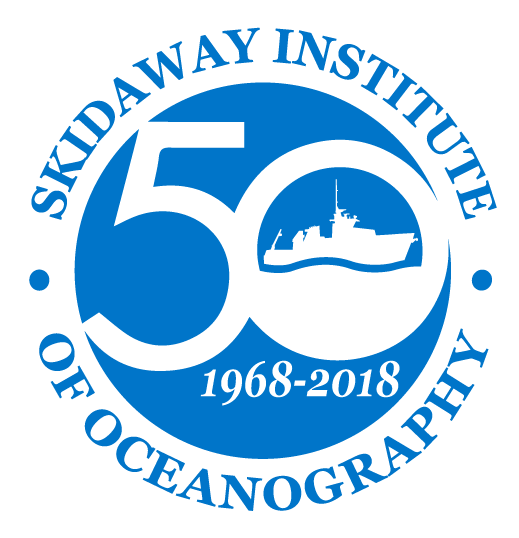UGA Skidaway Institute of Oceanography scientist Chris Marsay will spend much of the coming winter on board an ice breaker frozen solid in the Arctic ice cap. Marsay, working with fellow UGA Skidaway Institute researcher Clifton Buck, is part of a major international research project named Multidisciplinary drifting Observatory for the Study of Arctic Climate or “MOSAiC.” The plan is to sail the German ice breaker Research Vessel Polarstern into the Arctic Ocean until it becomes locked in the ice and leave it there to drift with the ice for a year, all the while using it as a headquarters for scientists to study Arctic climate change. The Polarstern left Norway in mid-September and has already become fixed in the ice pack. Marsay will sail aboard a Russian ice breaker to join the project in January and remain until early April.

R/V Polarstern
Photo credit: Stephanie Arndt/Alfred Wegener Institute
MOSAiC has been in the planning stages for more than ten years. It includes 17 nations and has a total budget exceeding $132 million. The project’s goal is to develop a better understanding of climate change, which is affecting the Arctic far more quickly and to a greater extent than anywhere else in the world. For example, satellite and other observations show that the area of sea ice coverage is shrinking. The ice is also becoming thinner and newer, meaning less of the ice persists for multiple years.
“The fundamental question is what will the Arctic look like when there is significantly less sea ice,” Buck said. “That will have physical and chemical implications, but it will also impact the biology of the region from polar bears all the way down to phytoplankton.”
Marsay’s role will be to monitor the atmospheric deposition of aerosols to the ocean and sea ice. This material is a mixture of tiny particles from sources including smoke from forest fires in places such as Alaska and Siberia, industrial emissions and natural dust blowing off the continents. The researchers hope to develop a better understanding of how nutrients and pollutants in this material make their way from the upper atmosphere to the ice cap. Aerosols can arrive either as particles, floating in the atmosphere and settling like dust, or as part of a raindrop or snowflake.
“We don’t fully understand the chemistry of the aerosol material,” Buck said. “We don’t have a good sense of the amount or how quickly it is being deposited, especially not in winter. It is extraordinarily difficult to conduct science in the Arctic in the winter.”
Marsay can expect temperatures of negative 30 or 40 degrees Celsius and constant darkness for much of his stay.

Chris Marsay during a 2015 expedition to the North Pole.
“The operational challenges are significant and the logistics are difficult,” Buck said.
Working with collaborators from Florida State University and Florida International University, the research team will use a radioisotope of beryllium to measure the rate of atmospheric deposition. Beryllium-7 is created only in the upper atmosphere by the exposure of nitrogen and oxygen to cosmic rays, and has a half-life of 53 days. By measuring the concentration of beryllium-7 in samples, they will be able to estimate the deposition rate at which beryllium and other materials are being deposited on the surface.
Marsay was required to undergo some very specialized training for the expedition.
“Generally when we go out to sea, there is a one or two hour meeting between the science team and ship crew to go over safety on board,” Marsay said. “For travelling on the Russian ice breaker, they have a condition that everyone has to have undergone a full sea survival training course.”
That was a two-day course that included firefighting and survival techniques, along with online learning. He also traveled to Colorado for a special course to learn to deal with another hazard – polar bears.
“They are the largest predator in the environment and are not afraid of anything,” Marsay said. “They are inquisitive, attracted to any activity, and they have no reason to leave once they come. They are a significant concern.”
Polar bears have already been spotted around the Polarstern for the past month and the bears have made repeated visits to the site. The ship has trained polar bear guards who will be out on the ice during working hours, but that may not be enough to protect the science teams.
“Because there will be so much going on around the ship, they want many pairs of eyes helping to keep a look out,” Marsay said.
Marsay’s training included a day of learning about the bears and a half day of firearm training, should an encounter with a bear get that far.
The research team will take turns working on the ship in shifts of two months at a time. As many as 40 to 50 scientists might be on the Polarstern during each shift, collecting samples and making a wide range of observations throughout the year.
“The powerful thing about this project is there are so many different angles being addressed,” Buck said. “The fact that all these different studies are being conducted at the same time and at the same place gives us the ability to really understand some of the fundamental processes going on in the Arctic.”
Participation in the MOSAiC project is funded by a four-year, $350,412 grant awarded to Buck by the National Science Foundation Arctic System Science Program.


